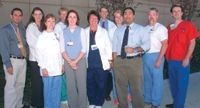Utah R.Ph.s do yeoman's service for Katrina victims
When the Gulf Coast was hit by hurricane Katrina in early September, hospitals and clinics were overwhelmed with seriously ill patients. Fortunately, overburdened healthcare systems in Louisiana and Mississippi got some relief when a number of states pitched in and offered to take on some of the patient overload.

Salt Lake City was one of the communities offering medical help to displaced storm victims. In an agreement between the governors of Utah, Texas, and Louisiana, Camp Williams, a National Guard training center near Salt Lake City, was transformed into a healthcare clinic on Sept. 4, 2005. Around 700 patients passed through the camp. About half, 340 to 350 of them, received medical attention.
At first, personnel from Utah's major healthcare systems-which included InterMountain HealthCare, the VA system, HCA, MountainStar, and the University of Utah Hospitals & Clinics-shared the staffing responsibilities. Each system rotated on a day-by-day basis, but with a new group of players on the scene every day there was no continuity of care, said James Jorgenson, director of pharmacy at University of Utah Hospital & Clinics (UUHC). He noted that some health systems didn't always send pharmacists to the clinic.
"A lot of the groundwork was already laid," said Jorgenson.
A triage unit was set up at the airport. Patients were treated on their arrival. Following health screenings, some patients were sent directly to the hospital; others made appointments to return to the clinic for a more comprehensive exam.
Kantesaria told Drug Topics that pharmacists administered a considerable number of antibiotics and immunizations, including those for hepatitis A tetanus and diphtheria. Some of the patients who required antibiotics had open wounds that were exposed to sewage in the seawater that flooded downtown New Orleans. Many patients who were suffering from diabetes and hypertension had not received their medications for a number of weeks. Others had chronic ailments such as HIV, pediatric HIV, and tuberculosis. At its peak the clinic was filling 250 Rxs per day.
"What surprised me most was how sick these people were," said Jorgenson. "Almost all of them needed some type of medical intervention." He said that healthcare officials in Utah were led to believe that these patients were going to be displaced people who had lost their homes and needed some help. They didn't expect the large numbers of severely ill patients, including some very elderly nursing home patients. "We got whoever they could put on the bus. There wasn't a lot of screening on the other end," Jorgenson said.
A lot of people, Kantesaria commented, had never had access to health care before the hurricane hit. "This is some of the best health care they ever received," he said. For one patient, it was the first time she had seen an OB/GYN, and she had already had five children.
The clinic closed on Sept. 23. The entire operation was a tribute to the versatility of pharmacists, said Jorgenson. "Pranish was doing things way beyond pharmacy. He had the skill sets to administer immunizations, help doctors with exams, dispense medications, coordinate prescriptions, and do record-keeping and billing."
Jorgenson said that everybody involved performed remarkably well. "It was nice that pharmacy was in a position to step up and take this responsibility."